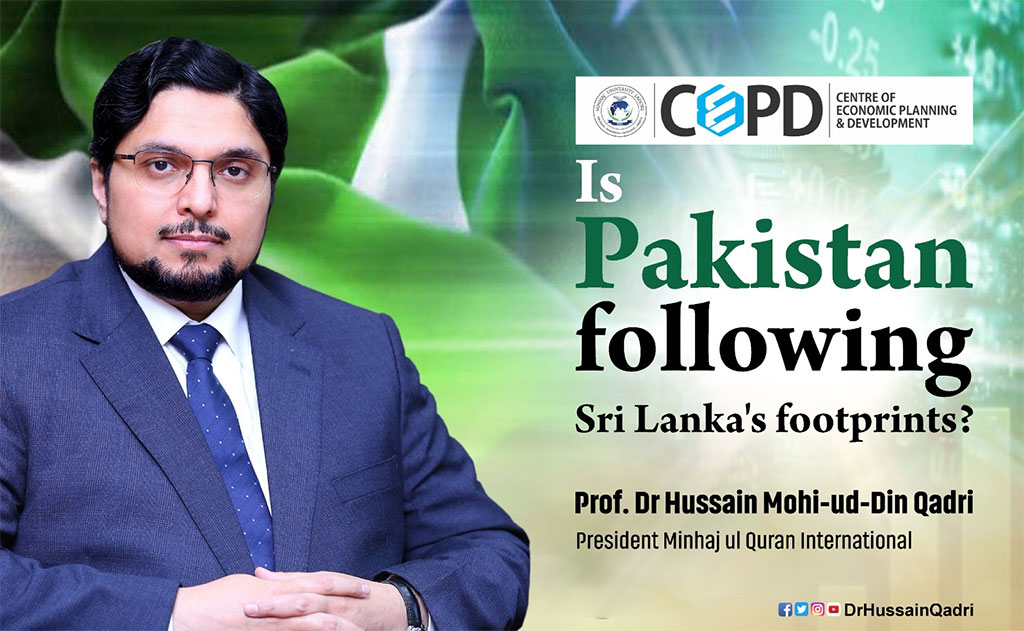Is Pakistan following Sri Lanka's footprints?: Prof. Dr. Hussain Mohi-ud-Din Qadri

Economists ascribe Sri Lanka's recent financial problems to a severe decline in tourism, remittances, and a substantial tax cut. It is claimed that Sri Lanka's economy relies heavily on tourism and remittances, and the covid epidemic has caused the island to be in its worst condition. Despite the size and diversity of Pakistan and Sri Lanka's economic resources, a significant decline in Pakistan's foreign exchange reserves and a political crisis have given the international community the impression that the country is following in Sri Lanka's footsteps. According to most recent statistics, Pakistan has twelve times the land area and ten times the population of Sri Lanka.
Pakistan's GDP per capita is half that of Sri Lanka's and Pakistan's GDP is four times larger. Although various factors led to Sri Lanka's economic collapse, poor government administration is at the top of the list. There is a worry that Pakistan's political upheaval and present global issues would produce conditions comparable to Sri Lanka. Does Sri Lanka's deteriorating economic status stem exclusively from the pandemic? Is everything occurring so quickly? Does Pakistan follow in the footprints of its neighboring island? What should Pakistan's government authorities learn from this episode? All of these points are addressed throughout the text.
Through "open economy reforms," Sri Lanka became the first nation in South Asia to liberalize its economy in the late 1970s. However, the island nation of Sri Lanka is currently a "state in crisis" mainly because of political, social, and economic problems. Sri Lanka is experiencing its most significant economic crisis since gaining independence from the British in 1948 and defaulted on foreign debt for the first time in its history. Availing of a month grace period, Sri Lanka defaulted on its financial obligations to its creditors in May 2022 when it failed to settle $78 million in debt interest. As a result, credit rating agencies deemed Sri Lanka default. According to the state bank of Sri Lanka, in 2021, compared to the pandemic area of 2019, the county's tourism and remittances decreased by 86 and 18 percent, respectively. Hence, the nation, which was once renowned for having a high human development index, is currently experiencing fuel, medicine, and cooking gas scarcity due to acute currency shortages that have halted imports.
Two political parties dominated the country's political system: Sri Lanka Freedom Party and United National Party. The government power moves between these two parties. Therefore, the parties used several populist activities, such as tax cuts and other subsidies, to gain more votes, dampening the country's overall economic efficiency. Therefore, Sri Lanka was moved to lower-middle-income nations in 2020, resulting from the government's failure to consider the impending crises and its use of populist tactics to win over more voters. According to the Asian Development Bank and the Sri Lankan Central Bank, after reaching an average growth rate of 6 percent from 2007 to 2016, Sri Lanka was classified as an upper-middle-income nation.
Does Sri Lanka move to default suddenly? Many economists commented on the Sri Lankan economic crisis have concentrated on the past two years. However, the country's inability to diversify its manufacturing base was the structural root cause of the economic collapse, which began three decades ago. Foreign remittances, tourism, and commodity exports are Sri Lanka's three most prominent sources of foreign exchange earnings. In contrast, the primary and recent causes of the financial catastrophe include the political crises, the substantial tax cut, terrorist assaults, the decline in tourism and remittances, and the COVID epidemic. Covid-19 proved to be a deadly blow to Sri Lanka's economy, which was already in freefall because of a failing tourism sector. In addition, a large hunk of overseas unskilled workers returned home and could not return to their jobs, resulting in a significant decline in remittances from overseas. Hence, after 2019, the island's foreign debt-to-GDP ratio skyrocketed to 120 percent. The country has a reserve of $ 1.5 billion from China for swap agreements exclusively, which cannot be used for import dollar payments. The economy was paralyzed by this crucial situation about what the country owned and owed.
As mentioned, The Sri Lankan economy is primarily based on tourism. In 2019, despite COVID and before planned terrorist acts, Sri Lanka welcomed over two million tourists and earned over four billion dollars. The remittances were $ 7.30 billion, while exports generated $ 20 billion in foreign exchange gains. However, numerous people were cruelly slain by terrorist bombings in Colombo churches and five-star hotels on the eve of Easter in 2019. After the civil war, Sri Lanka was confronted with this horrific violence. These terrorist attacks, which resulted in 267 fatalities and over 500 injuries, including 45 foreign nationals, precipitated a dramatic decrease in tourism, and Sri Lanka could not sustain its growth momentum. Terrorist assaults and the subsequent COVID shutdown accelerated the decline of the island's tourism industry, which is a significant source of foreign earnings. The Russia-Ukraine war is also one of the factors that caused the sudden and rapid decline in tourism. Hence, the economy of Sri Lanka suffered a severe blow due to the dramatic fall in tourist traffic that followed these attacks.
The current financial crisis may be traced back three decades to the civil war when Sri Lanka borrowed from international sources to rebuild infrastructure rather than invest in production-related industries. Consequently, exports' production base and growth shrank, and foreign earnings became dependent on remittances and tourism. Groups of the Tamil Tigers spawned terrorism and social unrest on the island. The Liberation Tigers of Tamil Eelam (LTTE), also known as the Tamil Tigers, crafted their military bases in the island's southern and eastern jungles. The Sri Lankan military responded to these groups, while the community organized anti-Tamil riots in Colombo in 1983.
Sinhalese organized mobs attacked Tamil property and forced Tamils to relocate to Tamil Nadu, the southernmost district of India. The Sinhalese are Sri Lanka's largest ethnic group, and more than 75 percent of the population belongs to this class. Sri Lanka and India offered the Tamils an integrated separate province in July 1987, and Tamil became an official Sri Lankan language alongside Sinhalese. In the interim, the Indian Peace-Keeping Force (IPKF) was deployed to ensure compliance with the terms of the agreement. However, the Sri Lankan government, the Tamil Tigers, and the IPKF officially opposed implementing this peace treaty. This time, the Tamil Tigers were offended by the IPKF because they believed it attempted to demilitarize them. In 1990, Sri Lanka compelled the IPKF to withdraw, and under the leadership of Prime Minister Premadasa, the army took the lead against the Tamil insurgency. Later, in 1993, the prime minister of Sri Lanka, Premadasa, was killed by a suicide bomb allegedly linked to the Tamil Tigers. In 2002, the Sri Lankan government unsuccessfully negotiated a cease-fire with Tamil tigers, and violence soon resumed.
2004 was challenging for Sri Lanka, as a tsunami struck the island and triggered earthquakes. This tragic event resulted in the deaths of over ten thousand people. The recovery from this shock was steady, except on the northern side, due to the ongoing political and military conflict. The European Union recognized the Tamil Tigers as a terrorist organization in 2006. In response, the Sri Lankan government formally revoked the 2002 cease-fire agreement and launched a vigorous military operation in 2008. The operation resulted in the deaths of the Tamil Tigers' leaders, including the founder. The state of war ended in 2009. It is estimated that over eighty thousand people were killed following the outbreak of the civil war in the early 1980s.
Although the civil war had the worst impact on Sri Lanka's economy, as 26-year war ended, the island started to recover. The Sri Lankan economy showed sustained growth over time, but there was considerable overdependence on foreign investment, especially from China. The balance of payment issue was evident in 2016, before the recent terrible financial crisis. However, the government negotiated a 1.5 billion-dollar bailout package with the IMF and set out to boost tax revenue. Nevertheless, the state provided a substantial tax cut due to an ongoing political crisis and the COVID pandemic. In 2017, Sri Lanka leased the newly constructed Hambantota port to China for 99 years and accepted $1 billion debt settlement on 2018.
A weak government was formed after terrorist attacks, a debt crisis, and a lack of support from Muslim and Tamil voters in the 2019 presidential election. The new government consequently announced a significant tax cut to gain the populace's support. It was regarded as one of the most pitiful economic decisions due to the burden of foreign debt, recent terrorism, and the ongoing COVID pandemic. However, Sri Lankan is established on the agriculture foundation. The country's large portion of the workers is attached to the agriculture sector, making it an agriculturist country. Despite these clear indications, the Sri Lankan government banned the import of chemical fertilizers to correct the balance of trade. It dealt a significant blow to the primary source of earnings and food supply. This unanticipated and sudden change precipitated a sharp decline in crop production and a massive increase in food prices. Thus, the burden of foreign debt increased. In November 2021, the ban was subsequently lifted.
Taking into account the current situation in Pakistan, the economy has far exceeded its threshold level of public debt and is unable to pay it. It needs desperate measures and helps from the global community. According to Bloomberg's Sovereign Debt Vulnerability Ranking report, Pakistan is in 4th, with the country having the highest risk of default in 2022. During the first week of January, the central bank's foreign exchange reserves dipped to $4.3 billion, the lowest level since February 2014. The risk of default increases as the government continuously declines its rupee concerning dollars to increase its export. It created further hurdles in debt repayment by increasing the interest that must be paid on debt. Moreover, as per the IMF report, the country dreadfully needs 7 billion dollars of loan disbursement to tackle this crisis. According to the IMF, Pakistan's total external debt will reach approximately $138 billion by the end of the fiscal year 2023. In the three years leading up to 2026, Pakistan must repay a total of $75 billion, or $25 billion per year.
There are signs of temporary relief. Pakistan viewed recently the $10 billion in pledges made by Pakistan's donors at the Geneva Climate Conference, but 90% of those pledges are in the form of project loans. Therefore, it is unlikely to aid with the immediate balance of payments crisis. Due to a $3 billion lifeline provided by the United Arab Emirates in the form of a rollover of $2 billion of existing debt and additional funding of $1 billion, Pakistan has managed to escape default temporarily. In addition, the Saudi Fund for Development agreed to finance $1 billion in oil imports on deferred payment.
As in Sri Lanka, is it occurring so rapidly? In terms of the roots of the financial crisis, Sri Lanka and Pakistan share many similarities. The economy of Pakistan took a turn in the 1980s when Pakistan became indulged in public debt due to its budget deficit. In addition, the country is also engaged in war with terrorism for the last several decades, like the civil war in Sri Lanka. With Pakistan at war with terrorism and continuously beleaguered by terrorist bombings in different cities of Pakistan, the country faces difficulties in paying for foreign input goods. In addition to the funds received for the fight against terrorism, the balance of payments held steady. Nevertheless, terrorism halted Pakistan's leading source of earnings in the global market and decreased Pakistan's dollar revenue. The rubbing salt wound the world economy hit by the Covid pandemic in early 2020. It constricted the Pakistan economy by taking away the leverage of domestic production due to the lockdown situation.
After the covid epidemic had several episodes, a war broke up between Ukraine and Russia. This war is essential for world as Russia is one of the major exporters of oil. As the price of importing oil increases, the cost of production of domestically produced goods increases because Pakistan is heavily based on foreign input supplies. In addition, the electricity price upsurges too many folds because of higher production costs. It caused many Pakistani-based industries to collapse and shut down their operations, such as the Nishat mill.
Pakistani society was once thought to be the most peaceful, but since the Russian invasion of Afghanistan in 1979, the country has experienced significant changes to its political and economic structure. The world powers provided substantial financial, military, and political support to the government of Pakistan and related militant organizations. In the 1980s, Pakistan became fertile ground for militant groups as the government and other stakeholders promoted an extremist mentality to recruit youth to fight against the Russian forces. The government, other political leaders, and related subgroups continued to enjoy the support of world powers. However, after the withdrawal of Russia from Afghanistan, these militant groups dispersed. The international community withdrew its support from these militant organizations, resulting in a complete shift in their agenda. These groups, which were highly well-resourced in terms of money, weapons, and religious political influence in the region, commenced fighting. Pakistan's geopolitical situation changed due to Russia's demise from the global order. In this altered context, terrorism firmly gripped and rapidly spread throughout Pakistani society.
During the Afghan War, Pakistan received and stored extended arms and ammunition, which these groups in sectarian tribal and political violence later used. In the meantime, political instability, corruption, social injustice, and economic disparity fueled the emergence of various manifestations of terrorism. It’s most obvious manifestation was sectarianism in the 1990s, precipitated by religious extremism. After 9/11, Pakistan again became the frontline state in the global war against terrorism. Pakistan effectively played its role in combating terrorism and militant groups, which increased terrorism in Pakistan. Terrorism increased intolerance and fear among the populace. Terrorism is currently one of the social ills not only in Pakistan but all over the world. From the past, we may deduce that Pakistan is a project economy and that it was the world's second project that sustained our foreign sector. Whenever the international community grants Pakistan a project, a balance of payments problem is never experienced. However, there is no such activity, and the financial crisis is worsening. Consequently, like Sri Lanka, our manufacturing base shrank, and our foreign income is now primarily derived from international projects, remittances, and exports with minimal added value.
The question of whether Pakistan is following Sri Lanka's footsteps arises. Is the Pakistani economy going to suffer the same destiny as the Sri Lankan economy? What similarities raise the chances of Pakistan having the same destiny as its neighbor Sri Lankan economy? To answer these questions, we need to understand what is common between Pakistan and Sri Lanka. Furthermore, to what extent do the similarities go on? The Pakistan economy produce agricultural products like the Sri Lankan economy, with both depending on imported foreign goods to produce domestically. However, focusing on the different aspects of the Sri Lankan economy is heavily based on the tourism sector. It brings many dollars into the economy. On the other hand, Pakistan is a beautiful country but not famous for tourist attractions due to the ongoing war against terrorism. However, the situation is changing in the last several years.
In the case of public debt, the Pakistani and Sri Lankan economies share the same path. The Sri Lankan economy was beyond the threshold level of debt, usually around 80 percent, and the Pakistani economy is now beyond that level. It is not the first time Pakistan has been on the brink of default. In the case of remittances, both countries face the worst decrease in remittances due to the unemployment on a massive level for overseas individuals, as economies around the world suffer dearly due to the covid epidemic. The number of remittances declines in both countries. In December, according to the most recent data from the State Bank of Pakistan, remittances decreased by 19 percent to $2 billion from $2.5 billion in the same month of the previous year. Due to the low value-added of their exports on the international market, these nations rely heavily on remittances as a significant source of foreign currency earnings.
Both nations were confronted with a similar form of terrorism. Pakistan engaged in a war against terrorism, initially against the Soviet Union and subsequently against numerous Taliban groups. The political turmoil in Sri Lanka began in the 1980s when the Tamil minority began an organized rebellion. Terrorism has sharply decreased in Pakistan. However, the 2019 bomb attack on churches has negatively affected the Sri Lankan economy. 2004 was a challenging year for Sri Lanka when a tsunami struck the island and prompted earthquakes. Pakistan also suffered terrible earthquakes in 2005. Concluding the preceding discussion, the Pakistani and Sri Lankan economies share many similarities and a similar trajectory. Both countries had been combating terrorism.
Historical similarities between Pakistan and Sri Lanka include a heavy reliance on remittances, fewer exports with low added value, a diminished manufacturing base, political instability, popular political tactics, a colonial institutional framework, and natural disasters. However, Pakistan has always maintained cordial relations with certain nations. As in the past, we continue to search for Pakistani allies to help us out of this circumstance. However, the underlying causes of financial problems are entirely disregarded.
Source : https://cepd.mul.edu.pk/Is_Pakistan_following_SriLanka_footprints.html












Comments